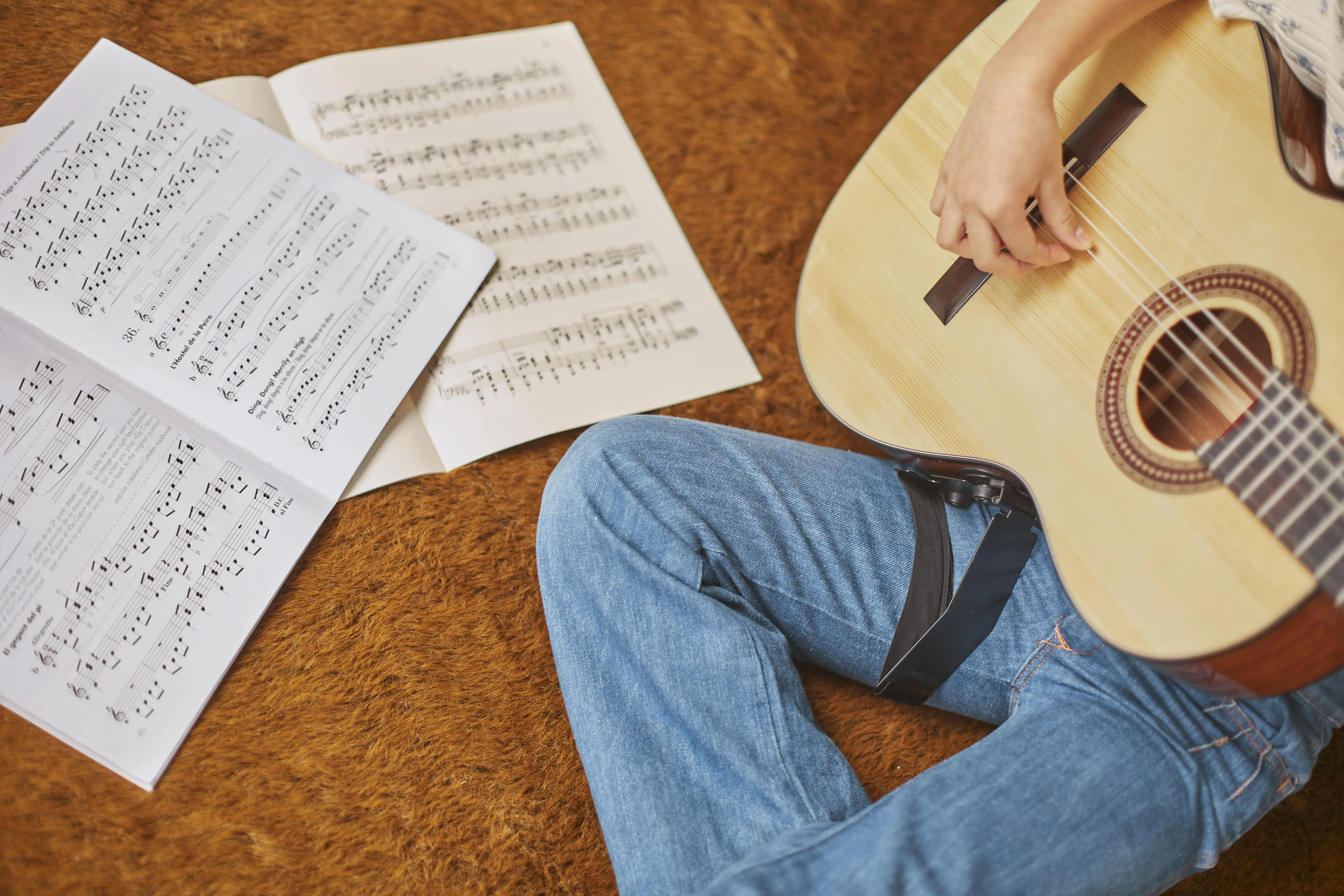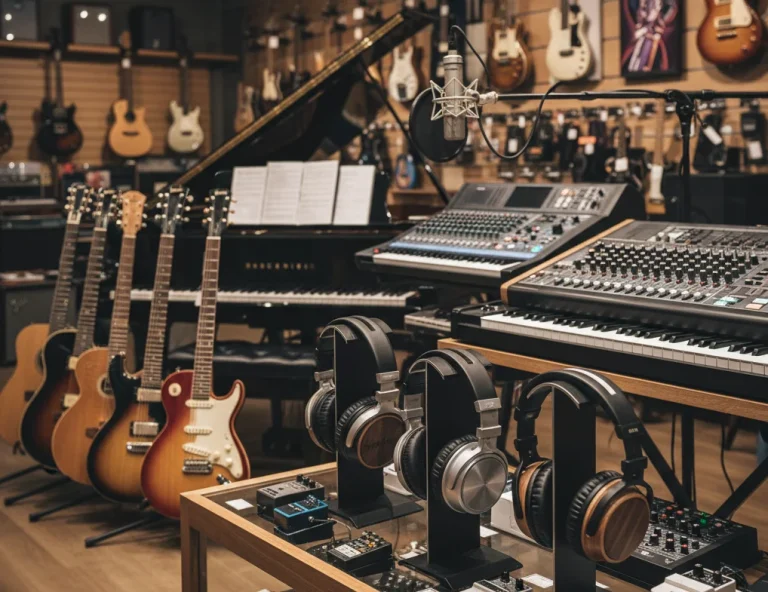All Topics
- Alchemizing Music Concepts for Students
- Artist Spotlight
- artium gift card
- Artium Maestros
- Artium News
- buying guide
- Carnatic Music
- Devotional Music
- Editorials by Ananth Vaidyanathan
- Film Music
- Guitar
- Hindustani Classical Music
- Indian Classical Music
- Indian Folk Music
- Insights
- Instruments
- Karaoke Singing
- Keyboard
- Kids Music
- maestros
- Music Education
- Music for Kids
- Music Industry
- Music Instruments
- Music Legends
- Music Theory
- Music Therapy
- Piano
- piano guide
- Success Stories
- Tamil Film Music
- Telugu Film Music
- Time Theory
- Tools
- Uncategorized
- Vocal Singing
- Vocals
- western classical music
- western music
- Western vocal music
How to Play Guitar: 14 Steps to Start Playing
How to Play Guitar: 14 Steps to Start Playing

Table of Contents
Learning how to play guitar can be an exciting journey. Whether you choose an acoustic or electric guitar, mastering this instrument means opening up a world of musical possibilities. This guide will cover essential steps—from choosing the right guitar to understanding guitar tuning, learning some basic chords, and more. Let’s dive right in.
How to Play The Guitar: Choosing Between An Acoustic and Electric Guitar
Close your eyes and picture yourself playing the guitar. Can you clearly see the exact guitar in your hands? Do you know what type it is? If you can, then you already know which guitar to buy. But before you decide, it’s good to understand the fundamental differences between acoustic and electric guitars.
Sound and Style: Acoustic guitars are known for their rich, warm sound and are ideal for playing folk, country, and classical music. They don’t require additional equipment and can be played anywhere. Whereas electric guitars are famous for rock, metal, jazz and blues with their distinctive crunch and distortion sound. Electric guitars require an amplifier to produce sound, which, when paired with effects pedals, opens up a world of sonic possibilities.
- Ease of Use: Beginners often start with acoustic guitars because they provide a straightforward learning experience without the need for amplifiers or cables, whereas electric guitars need amplifiers and electricity, which restricts their mobility.
- Musical Influences: Consider the genres of music you are interested in playing. Your preference will guide you in choosing between an acoustic or electric guitar.
- Budget: Acoustic guitars are generally more affordable as they do not require additional equipment such as amplifiers.
- Physical Comfort: Try playing both types of guitars to see which one feels more comfortable in your hands.
Buying Your First Guitar!
If you don’t have a guitar player buddy to help you pick out your first guitar, no worries! Just make sure you check these three things when you’re at the shop:
1. Comfort: Hold the guitar while sitting and standing to see if it feels right for you. Make sure the size and type are comfortable to play.
2. Intonation: This basically means the guitar stays in tune as you play different notes up and down the neck. Make sure the guitar has good intonation so that it sounds right no matter where you play.
3. Action: The action is the distance between the strings and the neck of the guitar. Ideally, it should be around 2-4mm at the 12th fret.
The luthier (the guitar expert at the shop) should be able to help you with the action and intonation.
Getting these basics right will set you up for a smoother playing experience!
How to Play The Guitar: Get to Know The Guitar Parts
Understanding the different parts of the guitar is essential for effective learning and maintenance. Here are the main components of a guitar:
- Body: The body of the guitar amplifies the sound produced by the strings. It comes in various shapes and sizes, affecting the instrument’s tone.
- Neck: The neck is the long, slender part of the guitar where the fretboard is located. It connects the headstock to the body.
- Fretboard: The fretboard is a flat surface with metal frets that help you play different notes and chords.
- Headstock: The headstock holds the tuning pegs, which are used to adjust the tension of the strings.
- Strings: Most guitars have six strings, each producing a different pitch. They are typically made of steel or nylon.
- Bridge: The bridge anchors the strings to the body of the guitar, transferring vibrations from the strings to the body.
- Pickups: Pickups are electromagnetic devices that capture the vibrations of the strings and convert them into electrical signals for amplification.
Learn How to Hold The Guitar
Properly holding the guitar is crucial for playing comfortably and effectively. Here are some tips for holding the guitar:
- Seated Position: Sit up straight with your lower back supported if needed. Rest the guitar on your right leg (if you are right-handed and vice versa if you’re left-handed) and keep the neck at a slight upward angle, almost parallel to the ground.
- Standing Position: Use a guitar strap to hold the guitar securely. Adjust the strap so that the guitar is at chest level, allowing you to play comfortably.
- Left-Hand Position: Place your left thumb on the back of the neck, allowing your fingers to reach the fretboard with ease.
- Right-Hand Position: Position your right hand preferably over the soundhole (acoustic) or pickups (electric), a pick to strum or pluck the strings.
How To Play The Guitar: Learn The Guitar Strings and Fretboard
Familiarising yourself with the strings and fretboard is essential for playing notes and to learn basic guitar chords.
String Names
Standard Tuning: The strings are typically tuned to the notes E, A, D, G, B, and e, from the thickest to the thinnest string. An acrostic to remember this is Eddie Ate Dynamite, Good Bye Eddie.
Fretboard Basics
- Fret lines: The metal bars on the fretboard are called fret lines, which divide the neck into different sections.
- Frets: The spaces between the fret lines are called frets and are used to produce different pitches on the guitar.
- Playing fretted Notes: In the case of a right-handed player, place the thumb of your left hand behind the neck of the guitar. Place the tip of your forefinger just behind the fret line and press it hard enough to produce a sound while simultaneously plucking the corresponding string with a pick in your right hand.
How to Play The Guitar: Understand Guitar Tuning
Proper guitar tuning is essential for producing accurate and pleasant sounds. The best way to tune your guitar is with tuning apps. Download a tuning app on your smartphone for convenience. Many apps offer visual and audio guidance for tuning.
Other tuning methods are as follows:
- Electronic Tuners: These are actual digital devices used for quick and accurate tuning. Simply pluck each string and adjust the tuning pegs until the tuner indicates the correct pitch.
- Tuning by Ear: Train your ear to recognize the correct pitch and tune the guitar manually by matching the sound of each string to a reference note.
How to Play The Guitar: Play Basic Guitar Chords
Learning basic guitar chords is the foundation of playing many songs. Start with the most common chords and gradually expand your repertoire.
Basic Chords
- Open Chords: Begin with open chords like G, C, D, E, A, Am, Em and Dm. These chords are played using open strings and are essential for beginners.
- Barre Chords: Once you are comfortable with open chords, progress to barre chords, which require pressing down multiple strings with one finger.
Chord Transitions
- Smooth Transitions: Practise switching between chords smoothly and quickly. This skill is crucial for playing songs with chord progressions.
- Finger Placement: Pay attention to finger placement to ensure each string rings clearly and without buzzing.
Learn How to Strum Guitar Chords
Playing chords on the guitar is incredibly satisfying, and strumming is an essential technique to master. Begin with straightforward patterns, like playing downstroke on every beat of a metronome, which is denoted as D D D D. As you get comfortable, try adding an upstroke between each consecutive downstroke to make your strumming more dynamic. A popular pattern to practise is D DU UDU.
Practice Patterns
4/4 & ¾ are the most common time signatures which are commonly used in many songs.
Experiment with patterns in 4/4 and 3/4 time signature for a different feel to begin with.
How to Play The Guitar: Read Guitar Tablature
Reading music is a vital skill that opens up a deeper understanding of musical structure and theory. It allows you to play a wider range of pieces accurately and communicate with other musicians effectively. Guitar players specifically use tablatures (tabs) to read music along with the staff notations.
Understanding Tablature
- Tab Lines: Tablature consists of six horizontal lines representing the guitar strings. The top line corresponds to the high e string, while the bottom line represents the low E string.
- Numbers: Numbers on the lines indicate which fret to press down on each string. For example, a “3” on the top line means to press down the third fret on the high e string.
- Symbols: Learn common symbols in tablature, such as bends, slides, and hammer-ons, to understand how to execute various techniques.
Advantages of Tablature
- Simplicity: Tablature is easy to read and understand, making it ideal for beginners who are not familiar with traditional sheet music.
- Accuracy: Tablature tells you the exact location of the note to be played on the fretboard.
- Song Learning: Many guitar songs are available in tab format, allowing you to learn your favourite songs quickly.
How to Play The Guitar: Practice Picking and Using a Guitar Pick
Mastering picking techniques and using a guitar pick effectively is essential for playing melodies and solos.
Picking Techniques
- Alternate Picking: Use alternate picking to play notes quickly and efficiently. This involves alternating between downstrokes and upstrokes.
- Economy Picking: Combine alternate picking with a focus on minimising hand movement for smoother and faster playing.
- Fingerstyle Picking: Explore fingerstyle picking, which involves using your fingers to pluck the strings individually, for a softer and more intricate sound.
Using a Guitar Pick
- Pick Grip: Hold the pick between your thumb and index finger, ensuring a firm but relaxed grip.
- Angle and Motion: Experiment with different pick angles and motions to find what feels comfortable and produces the best sound.
How to Play The Guitar: Learn Minor and Major Scales
Understanding scales is essential for playing solos, improvisation, and composing your own music.
Major Scales
C Major Scale: Start with the C major scale, one of the most fundamental scales. Practise playing it up and down the fretboard to develop dexterity. Learn different scale patterns and positions to expand your musical vocabulary.
Minor Scales
- A Minor Scale: The A minor scale is a natural starting point for learning minor scales. It shares the same notes as the C major scale, making it easy to understand.
- Pentatonic Scales: Explore pentatonic scales, which are commonly used in rock and blues music.
Start Playing Your Favourite Songs
Favourite artists:
One of the best ways to stay motivated while learning guitar is to start playing your favourite songs. This not only makes practice enjoyable but also helps you apply the techniques you’re learning in a real-world context.
Start simple:
Start with simple songs which use 4 chords throughout the song. If you are more interested in lead playing, look for melodies which can be played on one string, slowly increasing the complexity of melodies and chord progressions.
Practice Finger Exercises
Finger exercises are essential for building dexterity, strength, and coordination. Regularly practising exercises like scales, arpeggios, and stretches can make a significant difference in your playing ability.
These exercises help you develop muscle memory and finger independence, allowing you to play more challenging pieces with ease. Even just a few minutes a day can lead to noticeable improvements over time.
Develop Ear Training
Ear training is crucial for any musician, especially guitarists. It involves learning to recognize pitches, intervals, and chords by ear, which enhances your ability to play by ear, improvise, and understand music theory.
By developing a good ear, you’ll find it easier to transcribe music, pick up new songs quickly, and even create your own music. Incorporating ear training exercises into your routine can greatly expand your musical abilities.
There are many ear trainer apps available which can be downloaded on your phone for you to practise anytime.
Practice, Practice, Practice
Consistency is key when learning any instrument, and the guitar is no exception. As a beginner, start with a 15-minute practice routine everyday and gradually increase the practice time as per requirement.
Regular practice is the most important factor in your progress. Whether it’s working on new songs, perfecting techniques, or running through exercises, the more you practise, the better you’ll become. Remember, practising 15 minutes every day of the week will yield more results than practising 2 hours for one or two days of the week.
Learn How to Play The Guitar with Artium Academy
Many aspiring guitarists give up within the first 3 to 4 months due to a lack of motivation and the effort required to progress. Learning the guitar is a gradual process that demands consistent guidance and support to ensure the right effort is applied in the right direction for optimal results. At Artium, we recognize this challenge and provide continuous support throughout the student’s learning journey. With a personalised curriculum tailored to each student’s unique needs and one-on-one sessions, we not only help them achieve their goals faster but also ensure they enjoy the process along the way.
Conclusion
Learning to play the guitar is an exciting journey that brings a lot of satisfaction. From picking the right guitar to learning basic chords, each step helps you become a better player. The most important thing is to practise regularly and stay patient. Whether you start with simple songs or move on to more challenging techniques, every effort you make will help you improve. At Artium Academy, we’re here to support you every step of the way with personalised lessons and guidance, making sure you reach your goals and enjoy the process.








